Birds in the News #32
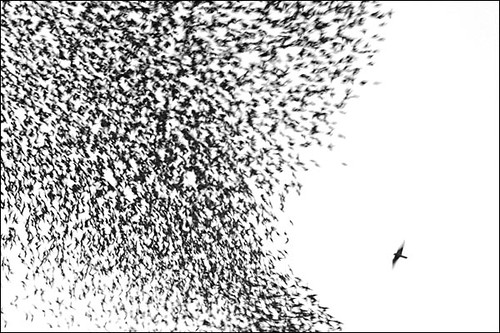
Sky Chase.
This stunning photograph resulted in Manuel Presti being named Wildlife Photographer of the Year by BBC Wildlife Magazine and London's Natural History Museum. (story below)
People Helping Birds:
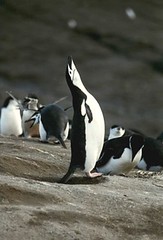 Imagine this: Sex in a minefield. This is a true-life story of how people are inadvertently helping birds. The star-crossed lovers are penguins, who are too light to detonate the deadly mines laid more than two decades ago during a war on the far-flung Falkland Islands. Thousands of penguins and other feathered and amphibious creatures choose to nest and rest in no-go zones. The British estimate that some 25,000 land mines, mostly sown by Argentine forces in the 1982 war with Britain, remain. Wildlife numbers in the mined areas appear to be on the rise and conservationists cannot hide their enthusiasm about this unorthodox form of protecting lands previously trampled by people or overgrazed by sheep. Grant Munro, director of Falklands Conservation, says the boost to wildlife is a bit anecdotal since "it has really not been looked into, for obvious reasons." He added; "But you see an assemblage of plants in the minefields, all fenced and inspected, with no livestock inside. Vegetation has had a chance to recover." (pictured: Chinstrap Penguin, Pygoscelis antarctica)
Imagine this: Sex in a minefield. This is a true-life story of how people are inadvertently helping birds. The star-crossed lovers are penguins, who are too light to detonate the deadly mines laid more than two decades ago during a war on the far-flung Falkland Islands. Thousands of penguins and other feathered and amphibious creatures choose to nest and rest in no-go zones. The British estimate that some 25,000 land mines, mostly sown by Argentine forces in the 1982 war with Britain, remain. Wildlife numbers in the mined areas appear to be on the rise and conservationists cannot hide their enthusiasm about this unorthodox form of protecting lands previously trampled by people or overgrazed by sheep. Grant Munro, director of Falklands Conservation, says the boost to wildlife is a bit anecdotal since "it has really not been looked into, for obvious reasons." He added; "But you see an assemblage of plants in the minefields, all fenced and inspected, with no livestock inside. Vegetation has had a chance to recover." (pictured: Chinstrap Penguin, Pygoscelis antarctica)The Society for Protection of Nature in Lebanon (SPNL, BirdLife in Lebanon), is reviving the hima, a traditional system under which communities manage natural areas such as woodlands, grasslands and wetlands, and protect them from over-exploitation. Two himas have been established in areas of high biodiversity; in Ebel es-Saqi (a potential Important Bird Area or "IBA", and raptor flyway bottleneck), and in the Kfar Zabad marshlands. Following Municipal Council decisions, hunting has been banned at both sites. Dating back at least to the sixth century, the hima system began to decline with modern changes in land use and transport, and the availability of imported livestock feed and other substitutes for natural resources. The hima system allows a mixture of strict protection and sustainable use, and one of its side effects has been the preservation of biodiversity. For example, one hima in Saudi Arabia was found to have vegetation cover of 47 percent, compared to just 8 percent outside the hima. As well as serving as refuges for birds and other wildlife, himas have great potential as seedbanks for regenerating the degraded lands around them. "SPNL believes that sustainability in the conservation of natural sites is more ensured when local people are involved," says Bassima Khatib of SPNL.
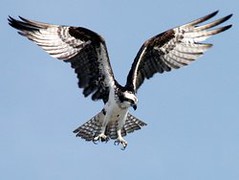 When an osprey, Pandion haliaetus (pictured), extends its wings, there's little that can compare with this bird of prey for grandeur. When viewed from below, which is almost always how the osprey is observed, its white wings have a black patch where they kink back at the elbow joint, giving the bird one of the most distinctive profiles in the avian world. Formerly rare, ospreys are making a resurgence in San Diego County [USA] and can be seen at all the coastal lagoons and many inland waterways. Patton said the overall population of osprey rebounded after the pesticide DDT was banned in the 1970s. The bird is not classified as threatened or endangered, but the state lists it as a species of special concern. "Their numbers have really increased during the last 20 years," said Robert Patton, an avian biologist and a board member of the San Elijo Lagoon Conservancy. "In the last 10 years we've seen significant numbers."
When an osprey, Pandion haliaetus (pictured), extends its wings, there's little that can compare with this bird of prey for grandeur. When viewed from below, which is almost always how the osprey is observed, its white wings have a black patch where they kink back at the elbow joint, giving the bird one of the most distinctive profiles in the avian world. Formerly rare, ospreys are making a resurgence in San Diego County [USA] and can be seen at all the coastal lagoons and many inland waterways. Patton said the overall population of osprey rebounded after the pesticide DDT was banned in the 1970s. The bird is not classified as threatened or endangered, but the state lists it as a species of special concern. "Their numbers have really increased during the last 20 years," said Robert Patton, an avian biologist and a board member of the San Elijo Lagoon Conservancy. "In the last 10 years we've seen significant numbers." Streaming Birds:
Featured this week on BirdNote are answers to those Burning Bird Questions (BBQs) that keep you awake at night; Steller's Jay, Cyanocitta stelleri, the mimic; How Raven, Corvus corax, Made the Tide (a Native American myth); the Pileated Woodpecker, Drycopus pileatus, a cartoon; raptors and wind farms; and what birds can hear in a song, featuring the
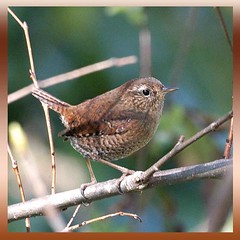 talented singer, the Winter Wren, Troglodytes troglodytes (pictured). BirdNote shows are two-minute vignettes that incorporate the rich sounds of birds provided by Cornell University and by other sound recordists, with photographs and written stories that illustrate the interesting -- and in some cases, truly amazing -- abilities of birds. Some of the shows are Pacific Northwest-oriented, but many are of general interest. BirdNote can be heard Monday through Friday, 8:58-9:00AM, throughout Western Washington and Southwest British Columbia and is also available as RSS/Podcast feeds. All episodes are available in the BirdNote archives, both in written transcript and mp3 formats, along with photographs. [mp3/podcast].
talented singer, the Winter Wren, Troglodytes troglodytes (pictured). BirdNote shows are two-minute vignettes that incorporate the rich sounds of birds provided by Cornell University and by other sound recordists, with photographs and written stories that illustrate the interesting -- and in some cases, truly amazing -- abilities of birds. Some of the shows are Pacific Northwest-oriented, but many are of general interest. BirdNote can be heard Monday through Friday, 8:58-9:00AM, throughout Western Washington and Southwest British Columbia and is also available as RSS/Podcast feeds. All episodes are available in the BirdNote archives, both in written transcript and mp3 formats, along with photographs. [mp3/podcast].Bird Flu News:
"Bird flu" has caused people to ask questions, but there are few concrete answers available. For example; are birders and people who feed wild birds more likely to get avian influenza than the average person? Of the more than 135 different strains of the influenza virus found in wild birds, only one is potentially pathogenic to humans; H5N1. For more information about avian influenza, please check out this informative article with outside links about Avian Influenza published by the Seattle Audubon Society. GrrlScientist note: A reader correctly points out that all strains of Influenza are potentially pathogenic to humans. Unfortunately, I failed to make this clear when quoting this story here.
Circumstantial evidence is mounting that wild birds are carrying the H5N1 virus along major migratory pathways. The virus has been linked to ducks moving through Europe's Danube delta. Though no solid proof exists so far, concern is growing that these ducks could play a role in creating a flu pandemic. [National Public Radio; mp3/podcast].
But really, after all these dire warnings about wild migratory birds acting as a vector for bird flu, who REALLY is more likely to bring Avian Influenza into a "clean" country; birds or people? According to Spanish ornithologists, air passengers are more likely to bring bird flu to Spain than wild birds. Alejandro Sanchez, head of the Spanish Ornithology Society, explained that the migration routes of wild birds from Southeast Asia do not pass through Spain, so the country's wild birds are less likely to spread the epidemic.
Thus, in some countries, the avian influenza threat is prompting the demand for a detailed study of behaviour of migratory birds. A group of ornithologists will soon seek approval for this nationwide project with officials from the Indian Ministry of Environment and Forests. This research project will document the flyways followed by migratory birds and will rely upon volunteer networks, as well as the skills of the forest and agriculture officials. Migratory birds will monitored at Haigam and Hokasur in Kashmir, Pong Dam in Himachal Pradesh, Harike in Punjab, Keoladeo National Park in Rajasthan, Kahar Lake in Bihar and Chilka lake in Orissa. The birds that will be monitored are the brown-headed gull, Larus brunnicephalus, Palla’s gull, Larus ichthyaetus, great cormorants, Phalacrocorax carbo, and bar headed geese, Anser indicus -- all species travel great distances to winter in India. The birds will be marked with normal rings [leg bands] as well as satellite rings to track their migratory patterns. Satellite tags would be fitted as backpacks on the birds, after taking their faecal and blood samples. This would help locate them if any H5N1 virus were detected.
Miscellaneous Bird News:
If you've been following the Bird Flu stories, you might think that all ducks are "Demon Ducks of Doom". But speaking of Demon Ducks of Doom, this particular duck looks like it could be something straight out of Jurassic Park -- caught in a dramatic, running stance, it is the Burke museum's [University of Washington, Seattle, USA] latest arrival -- a nine-foot skeleton cast of the largest bird ever to roam the earth -- is nearly impossible to overlook. The ancient Australian creature, known as the Mihirung, a member of the extinct dromornithidae family of birds, is now a permanent part of the Burke's collection. An extreme rarity, the UW possesses one of the only two Mihirung skeleton casts on display in the world. The other resides in an Australian museum."The bird came in a crate, in many pieces, with all of the limbs separate," said Liz Nesbitt, the Burke's paleontology curator. "It took us over six hours to simply get it out of the crate -- especially since the enormous box was filled with Styrofoam packing peanuts." The Mihirung skeleton is a permanent installation in the museum.
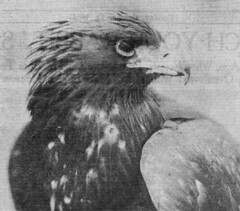 I'll bet that you never learned about the famous Battle Bird in your US History classes, did you? This is the story of Wisconsin's famed battle bird, a tame bald eagle, Haliaeetus leucocephalus, named Old Abe (pictured at left), after President Abraham Lincoln. Old Abe was the mascot for the Eau Claire "Badgers" Company C 8th regiment during the Civil War (this regiment was renamed the "eagles" in honor of Old Abe). During his period of military service, Old Abe traveled 14,000 miles with his regiment. After the war concluded, he was brought back to Wisconsin and given to the state, where he lived in a two-room apartment in the basement of the capitol in Madison. In 1881, oil and paint that were kept close by Old Abe's room ignited. The eagle was rescued but he later died from inhaling the fumes. But Old Abe was not forgotten: even to this day, soldiers in the Army's 101st Airborne Division have an image of Old Abe on their shoulder patch, and a replica of Old Abe is perched above the Speaker's Podium in the Assembly Chambers in the capitol. [Another story about Old Abe].
I'll bet that you never learned about the famous Battle Bird in your US History classes, did you? This is the story of Wisconsin's famed battle bird, a tame bald eagle, Haliaeetus leucocephalus, named Old Abe (pictured at left), after President Abraham Lincoln. Old Abe was the mascot for the Eau Claire "Badgers" Company C 8th regiment during the Civil War (this regiment was renamed the "eagles" in honor of Old Abe). During his period of military service, Old Abe traveled 14,000 miles with his regiment. After the war concluded, he was brought back to Wisconsin and given to the state, where he lived in a two-room apartment in the basement of the capitol in Madison. In 1881, oil and paint that were kept close by Old Abe's room ignited. The eagle was rescued but he later died from inhaling the fumes. But Old Abe was not forgotten: even to this day, soldiers in the Army's 101st Airborne Division have an image of Old Abe on their shoulder patch, and a replica of Old Abe is perched above the Speaker's Podium in the Assembly Chambers in the capitol. [Another story about Old Abe]. The black and white image of a peregrine falcon sweeping into a flock of starlings (pictured at top) won Manuel Presti this year's Wildlife Photographer of the Year award. The Italian caught the action scene, titled Sky Chase, high above a city park in Rome. "Sky Chase is a powerful image and, like it or not, it's one that you will never forget," said Mark Carwardine, one of this year's judges. "The sky was cloudy so I overexposed the image intentionally to make it white. A slow shutter speed - 1/50th of a second - gives it this dynamic of the starlings moving under the psychological pressure of the peregrine diving," said Presti. The competition, organised by BBC Wildlife Magazine and London's Natural History Museum, is one of the most prestigious in world photography. This photo won the Animal Behaviour: Birds category as well as the overall title, and was chosen from 17,000 entries from over 55 countries.
The founder of Ronin Air Falconry Services, Jeff Diaz, was in the midst of a series of antics designed to find, lure and retrieve a bird that escaped from his truck last Sunday. Wearing a bucket hat and fatigues, Diaz jumps around near his truck and claps his hands. Then he fires a .22-caliber blank that emits a screaming whistle. He is trying to scare
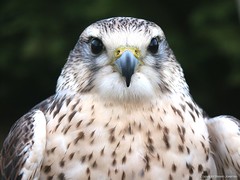 off a murder of crows, but succeeds only in frightening a woman and her dog. Jake the Saker falcon, Falco cherrug (A Saker Falcon portrait is pictured at right), is Diaz’s fifth escapee in three years. Diaz had been training the bird to intimidate sea gulls on Capitola Beach, advertising two aspects of his business on the back of his white Ford Tundra: falconry demonstrations, and "Environmental Bird Pest Control." Though he has not been hired by the City of Capitola, Diaz claims he and his falcons should be employed there to eradicate a long-standing water-pollution problem caused by sea gulls. "He calls every couple months," says Steve Jesberg, city public works director. "But we have no active interest. He just hasn’t gotten that message." GrrlScientist comment: as a fellow job seeker, I think Diaz deserves credit for having balls AND birds.
off a murder of crows, but succeeds only in frightening a woman and her dog. Jake the Saker falcon, Falco cherrug (A Saker Falcon portrait is pictured at right), is Diaz’s fifth escapee in three years. Diaz had been training the bird to intimidate sea gulls on Capitola Beach, advertising two aspects of his business on the back of his white Ford Tundra: falconry demonstrations, and "Environmental Bird Pest Control." Though he has not been hired by the City of Capitola, Diaz claims he and his falcons should be employed there to eradicate a long-standing water-pollution problem caused by sea gulls. "He calls every couple months," says Steve Jesberg, city public works director. "But we have no active interest. He just hasn’t gotten that message." GrrlScientist comment: as a fellow job seeker, I think Diaz deserves credit for having balls AND birds.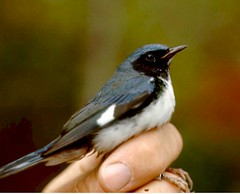 Although Alexander Wilson and John James Audubon were outstanding early ornithologists, they still made errors in identifying North American songbirds. One confusing fall migrant that gave them fits -- Hilton Pond refers to as Audubon's Extra Warbler (a breeding plumaged male of this species is pictured at left) -- is the topic of discussion for the latest in This Week at Hilton Pond. As always, they included a list of all birds banded during the previous week, as well as a few nature notes and a comment about their waning numbers of Ruby-throated Hummingbirds, Archilochus colubris.
Although Alexander Wilson and John James Audubon were outstanding early ornithologists, they still made errors in identifying North American songbirds. One confusing fall migrant that gave them fits -- Hilton Pond refers to as Audubon's Extra Warbler (a breeding plumaged male of this species is pictured at left) -- is the topic of discussion for the latest in This Week at Hilton Pond. As always, they included a list of all birds banded during the previous week, as well as a few nature notes and a comment about their waning numbers of Ruby-throated Hummingbirds, Archilochus colubris.Birdwatchers are in a flutter after a rare species was spotted for the very first time on the Scottish mainland. Hundreds of avid twitchers from all over the UK have flocked to the car park at Torness power station after a local
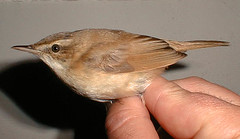 birdwatcher first caught sight of the paddyfield warbler, Acrocephalus agricola, on Thursday. Ornithology experts said today the sighting of the small brown and white bird, which breeds in sites along the Black Sea coasts of Romania and Bulgaria, was the first of its kind ever spotted on mainland Scotland. "Several hundred people have already been from all over the UK to see it. It has been seen in Kent and Cornwall but is a very rare bird. It's small, about the size of a blue tit, brown and white and isn't going to win any beauty contests," said Peter Macdonald, a dedicated birdwatcher who lives just minutes away from the East Lothian site where he captured the vagrant bird on film.
birdwatcher first caught sight of the paddyfield warbler, Acrocephalus agricola, on Thursday. Ornithology experts said today the sighting of the small brown and white bird, which breeds in sites along the Black Sea coasts of Romania and Bulgaria, was the first of its kind ever spotted on mainland Scotland. "Several hundred people have already been from all over the UK to see it. It has been seen in Kent and Cornwall but is a very rare bird. It's small, about the size of a blue tit, brown and white and isn't going to win any beauty contests," said Peter Macdonald, a dedicated birdwatcher who lives just minutes away from the East Lothian site where he captured the vagrant bird on film.Special Announcements:
Incidentally, the next issue of the Bird Blog Carnival, I and the Bird, will be published here on the 27th of October. I am seeking both author submissions and reader nominations of blogged writing and photographs about birds for this blog carnival. Please send links to me by the 26th of October.
Thanks to my bird pals; Ellen, Bill, Robin, Adele, Caren, Jennifer, Richard & Cyndy and Ron for some of the links you are enjoying here.
tags: Birds in the News, ornithology, birds, avian, newsletter
© 2004, 2005, 2006 by GrrlScientist











8 Peer Reviews:
Hi Hedwig,
I disagree with your comment that "Of the more than 135 different strains of the influenza virus found in wild birds, only one is potentially pathogenic to humans; H5N1." All of the avian flu strains are "potentially pathogenic;" we just know that certain strains of H5N1 definitely are. We also have some evidence from studies of duck hunters and DNR workers who routinely tag and release ducks that they may be sub-clinically infected with avian viruses more frequently than is currently appreciated, but that's not been published yet. I wouldn't use this as an excuse to stay away from birds, though. I live in rural Iowa and we have many species of hawks, and several osprey nest near a local lake. Looking forward to the return of the bald eagles (got a pic of 2 of them in a tree in our backyard last year).
Thanks for the photos!
dead parrot with H5 virus found in UK - in quarantine so does not affect UK's disease free status.
I've had enough bad news this week, so don't want to talk about viruses. But I DO think that first photo was stupendous. That is sort of what I saw on the canoe trip--but to untalented to catch that! Of course we were moving pretty fast from the wind.
I love that osprey photo. What a spectacular bird. I'm working on something for I and the Bird. Hope to have it posted this weekend and will send you a link.
Mining for habitat preservation! A little drastic, perhaps, but strangely cheering....Thanks for the story.
Turns out the african grey attempting to side step quarantine in UK did not have the dreaded H5N1 virus after all; it was just pining for the fjords.
squawk - stop press- parrot did have the n1 type virus after all. We're all doomed I tell you, doomed.
special program on avian flu 4 minutes past midday on BBC world service, today
Post a Comment
<< Home